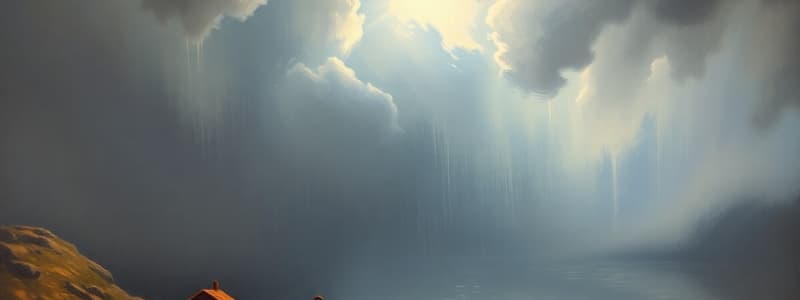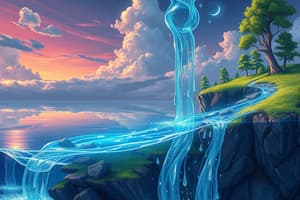Podcast
Questions and Answers
Which process involves water changing from a gaseous state to a liquid state?
Which process involves water changing from a gaseous state to a liquid state?
- Evaporation
- Transpiration
- Condensation (correct)
- Precipitation
What primarily drives the processes of evaporation and transpiration in the water cycle?
What primarily drives the processes of evaporation and transpiration in the water cycle?
- Wind
- Gravity
- Ocean currents
- The sun's energy (correct)
What is the primary factor that determines the characteristics of an air mass?
What is the primary factor that determines the characteristics of an air mass?
- Cloud cover
- Temperature and humidity (correct)
- Wind speed
- Air pressure
What type of weather is typically associated with a cold front?
What type of weather is typically associated with a cold front?
What is the Coriolis effect, and how does it influence global patterns?
What is the Coriolis effect, and how does it influence global patterns?
How do gyres contribute to the distribution of heat around Earth?
How do gyres contribute to the distribution of heat around Earth?
What drives the deep ocean currents that are part of the overturning circulation?
What drives the deep ocean currents that are part of the overturning circulation?
In what way does latitude affect a region's climate?
In what way does latitude affect a region's climate?
How do large bodies of water influence the climate of nearby regions?
How do large bodies of water influence the climate of nearby regions?
What is a 'rain shadow' and how does it form?
What is a 'rain shadow' and how does it form?
Flashcards
Water Cycle
Water Cycle
The continuous movement of water between Earth’s surface and the atmosphere.
Evaporation
Evaporation
The change of water from liquid to vapor.
Transpiration
Transpiration
The evaporation of water from plants into the atmosphere.
Condensation
Condensation
Signup and view all the flashcards
Precipitation
Precipitation
Signup and view all the flashcards
Weather
Weather
Signup and view all the flashcards
Air Mass
Air Mass
Signup and view all the flashcards
Weather Front
Weather Front
Signup and view all the flashcards
Prevailing Winds
Prevailing Winds
Signup and view all the flashcards
Climate
Climate
Signup and view all the flashcards
Study Notes
- The water cycle involves the continuous movement of water between Earth’s surface and the atmosphere.
- This movement occurs through physical processes.
Movement Into the Atmosphere
- Water enters the atmosphere from oceans, lakes, and streams through evaporation.
- Evaporation is the process where liquid water turns into water vapor (a gas).
- Transpiration is another way water enters the atmosphere, involving the evaporation of water from plants.
- Both evaporation and transpiration are powered by the sun's energy.
Cloud Formation
- Condensation is how water vapor in the atmosphere forms clouds.
- Condensation is the process where water vapor transforms into liquid water.
Precipitation and Surface Water
- Precipitation is when water falls back to Earth’s surface, driven by gravity.
- Some water that reaches land flows downhill as runoff.
- Some water soaks into the ground and becomes groundwater.
Weather Defined
- Weather is the atmospheric condition at a specific place and time, characterized by factors like temperature, rain, and wind.
- Changes in weather are due to the movement of air masses.
- An air mass is a large volume of air with consistent temperature and humidity.
- Air masses generally move from areas of high pressure to areas of low pressure.
Weather Fronts
- Weather fronts form when air masses collide.
- A cold front forms when a cold air mass moves into a warm air mass, typically bringing cooler temperatures, heavy rain, or thunderstorms.
- A warm front forms when a warm air mass moves into a cold air mass, usually resulting in warmer temperatures and moderate rain.
Weather Prediction
- Scientists predict weather by gathering current data and using computer models.
- Due to the complexity of weather, predictions are probabilities, not certain outcomes.
Currents Explained
- A current is a steady flow of fluid (air or water) within a larger body of that fluid.
- Prevailing winds are air currents that predominantly blow in a single direction.
- The uneven heating of Earth’s surface causes the global pattern of prevailing winds.
Surface Currents and the Coriolis Effect
- Surface currents in the ocean are created as prevailing winds blow across the water.
- Both prevailing winds and surface currents curve because of Earth’s rotation; this is the Coriolis Effect.
Gyres
- Surface currents connect, forming large, rotating systems known as gyres.
- Gyres circulate heat around the Earth by moving warm water from the equator toward the poles.
Deep Currents and Overturning Circulation
- Density differences drive deep ocean currents.
- Denser water, which is colder and saltier, sinks; less dense water, which is warmer and less salty, rises.
- Vertical currents connect via horizontal currents at the surface and in the deep ocean.
- Together this system of currents is called the overturning circulation.
Climate Defined
- Climate is the long-term weather pattern in a specific region.
- Many factors influence a region’s climate.
Latitude's impact on Climate
- Latitude is the distance north or south from the equator.
- Higher latitudes receive less direct sunlight, resulting in cooler climates.
Elevation's impact on Climate
- Elevation is a place's height above sea level.
- Air cools as it rises to higher elevations, leading to cooler temperatures.
Geographic Features' impact on Climate
- Geographic features are elements of Earth’s surface like large bodies of water or mountain ranges.
- Large bodies of water moderate air temperatures, leading to milder climates near oceans or lakes.
- Mountain ranges can create a rain shadow, which is an area of reduced rainfall on the range's leeward side.
- Rain shadows have warmer and drier climates compared to the other side of the mountain range.
Studying That Suits You
Use AI to generate personalized quizzes and flashcards to suit your learning preferences.




